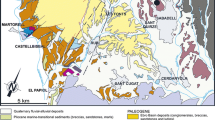Abstract
A newHomo erectus cranium was found on May 18, 1993 by Budi, a local farmer, at Sangiran. It dates from the Middle Pucangan Formation approximately 1.6–1.8 mya. The braincase is essentially complete and as is most of the face. The vault has the typicalH. erectus gable shape. There is a clear sagittal ridge beginning below the middle of the frontal squama and running to mid-parietal. Parasagittal ridges are rounded angulations halfway up the parietals, and coincide with poorly marked temporal lines. In all measurements, this skull is longer and consistently narrower than Trinil. It is chronologically and morphologically similar to the famousH. erectus skull from east Africa, KNMER-3733. Although existing much older, this new specimen is what one would expect a female counterpart to Sangiran 17 to look like.
Similar content being viewed by others
Literature cited
Bar-Yosef O (1994)The Lower Paleolithic of the Near East. Journal of World Prehistory, 8: 211–265.
Brauer G and M Schultz M (1996)The morphological affinities of the Plio-Pleistocene mandible from Dmanisi, Georgia. Journal of Human Evolution, 30: 445–481.
Curtis G H (1981)Man's immediate forerunners: Establishing a relevant time scale in anthropological and archaeological research. Phil. Trans. Roy. Soc. London, Series B, 292: 7–20.
Dennell RW, Rendell HM, Hurcombe L and Hailwood EA (1994)Archaeological evidence for hominids in Pakistan before one million years ago. Courier Forschungs-Institute Senckenberg 171: 151–155.
De Vos J (1985)Faunal stratigraphy and correlation of the Indonesian hominid, sites. In: (Delson E., ed.) Ancestors: The Hard Evidence. Liss, New York 215–220.
De Vos J (1995)The migration of Homo erectus and Homo sapiens in Southeast Asia and the Indonesian Archipelago. In Evolution and Ecology of Homo erectus. Bower J and Sartono S (eds) Leiden University, The Netherlands.
De Vos J and Sondaar PY (1994)Dating hominid sites in Indonesia. Science 266: 1726–1727.
Feibel CS, Brown FH and Mc Dougall I (1989)Stratigraphic context of fossil hominids from the Omo Group deposits: Northern Turkana Basin, Kenya and Ethiopia. American Journal of Physical Anthropology, 78:595–622.
Huang WR, R Ciochon, and G Yumin (1995)Early Homo and associated artefacts from Asia. Nature 378:275–278.
Jatmiko BP (1996)A study of hominid evolution in Java. Unpublished Master's Thesis, Dept. of Anthropology, University of Idaho.
Kramer A (1989)The evolutionary and taxonomic affinities of the Sangiran mandibles of Central Java, Indonesia. Unpublished Ph. D. dissertation, The University of Michigan, Ann Arbor.
Kramer A and LW Konigsberg (1994)The phyletic position of Sangiran 6 as determined by multivariate analyses. Courier Forschungs-institut Senckenberg 171:105–114.
Leakey RE and Walker A (1976)Australopithecus, Homo erectus and the single species hypothesis. Nature, 261:572–574.
Leakey RE and Walker A (1985)Further hominids from the Plio-Pleistocene of Koobi Fora, Kenya. American Journal of Physical Anthropology, 67:135–163.
Nishinmura S, Ikeda T, and Yokoyama T (1980)A fundamental investigation on the fission-track method. Report for Grant-in-Aid for Scientific Research, pp. 5–11.
Orchiston DW and WG Siesser (1982)Chronostratigraphy of the Plio-Pleistocenefossil hominids of Java. Mod. Quat. Res. SE Asia 7:131–149.
Pope GG (1983)Evidence on the age of the Asian Hominidae. Proceedings of the National Academy of Sciences 90:4988–4992.
Pope GG (1988)Recent advances in Far Eastern paleoanthropology. Ann. Rev. Anthropol. 17:43–77.
Pope GG and JE Cronin (1984)The Asian Hominidae. Journal of Human Evolution 13: 377–396.
Rightmire GP (1990)The evolution of Homo erectus: comparative anatomical studies of an extinct human species. Cambridge University Press.
Sartono S (1968)Early Man in Java: Pithecanthropus VII, a Male Specimen of Pithecanthropus Erectus (I). Proceedings of the Knoninklijke Nederlands Akademie van Wetwnschappen, Amesterdam 71 (B):5.
Sartono S (1975)Implications Arising from Pithecanthropus VII. In: (R.H. Tuttle ed.) Paleoanthropology: morphology and paleoecology, pp. 327–360. The Hague, Mouton.
Sartono S (1980)Pre-sapiens migration in Southeast Asia. International Association Historians of Asia, VIIIth Conference, Kualaumupur (Malaysia).
Sartono S (1991)Homo (Pithecanthropus) Erectus: Le Debat Fin. L'Anthropologie (Paris), 95:123–126.
Sartono S, Sighinolfie G.P. and Artioli G. (1993).Chemical and Mineralogical Studies on Hominid Remains from Sangiran, Central Java (Indonesia). Journal of Human Evolution 24:57–68.
Sonadaar PY (1984)Faunal evolution and the mammalian biostratigraphy of Java. Cour. Forsch. Inst. Senckenberg, 69:219–235.
Suzuki M and Wikarno B (1982)Fission-tracks ages of pumice tuffs layers and javites of hominid bearing formations in Sangiran, Central Java.. Comm XI Int. Congr. Moscow, INQUA, 2:322.
Suzuki M, Wikarno B, Saefudin I, and Itihara M (1985)Fission track ages of pumice tuff, tuff layers and Javites of hominid fossil bearing formations in Sangiran area, Central Java. In: Watanabe N and D Kadar (eds.) Quaternary Geology of the Hominid Fossil Bearing Formations in Java: Report of the Indonesia-Japan Joint Research Project CTA-41, 1976–1979. Special Bulletin Number 4. Bandung Indonesia: Geological Research and Development Centre, pp. 309–358
Swisher C C, Curtis GH, Jacob T, Getty AG, Suprijo A, and Widrasmoro (1994)Age of the earliest known hominids in Java, Indonesia. Science 263:1118–1121.
Watanabe N and D Kadar (eds.) (1985)Quaternary Geology of the Hominid Fossil Bearing Formations in Java. Report of the Indonesian-Japan Joint Research Project CTA-41, 1976–1979. Special Bulletin Number 4. Bandung, Indonesia: Geological Research and Development Centre.
Weidenreich F (1943)The skull of Sinanthropus pekinensis: A comparative study on a primitive hominid skull. Paleont. Sinica, new Series D, number 10, whole Series number 127:1–484.
Widiasmoro and S Boedhisampurno (1993)The Pleistocene Paleoecology of Sangiran, Central Java. Proyek Penelitian Paleoanthropologi Nasional.
Yokoyama T, Hadiwisastra S, Hantoro W, Matsuda T, and Nishimura S (1980)K-Ar age of the Lahar Tuff lowest part of the Pucangan Formation, Pleistocene of Sangiran, Central Java, Indonesia. Riset. Geologi dan Pertambangan, LIPI, 3:1–7.
Author information
Authors and Affiliations
Rights and permissions
About this article
Cite this article
Tyler, D.E., Sartono, S. A newHomo erectus cranium from Sangiran, Java. Hum. Evol. 16, 13–25 (2001). https://doi.org/10.1007/BF02438919
Issue Date:
DOI: https://doi.org/10.1007/BF02438919




